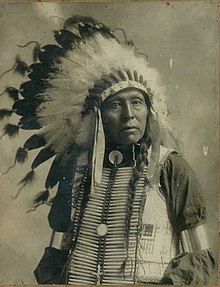Flying Hawk | |
|---|---|
Čhetáŋ Kiŋyáŋ | |
 Chief Flying Hawk, Čhetáŋ Kiŋyáŋ. | |
| Oglala Lakota leader | |
| Personal details | |
| Born | March 1854 Rapid Creek, Lakota Territory |
| Died | December 24, 1931 (aged 77) Pine Ridge, South Dakota |
| Spouse(s) | White Day Goes Out Looking |
| Relations | Kicking Bear (brother) Black Fox II (half brother) Crazy Horse (first cousin) Sitting Bull (uncle) |
| Children | Felix Flying Hawk (son) |
| Parent(s) | Black Fox (father) Iron Cedar Woman (mother) |
Flying Hawk (Oglala Lakota: Čhetáŋ Kiŋyáŋ; March 1854 – December 24, 1931), also known as Moses Flying Hawk, was an Oglala Lakota warrior, historian, educator and philosopher. Flying Hawk's life chronicles the history of the Oglala Lakota people through the 19th and early 20th centuries, as he fought to deflect the worst effects of white rule; educate his people and preserve sacred Oglala Lakota land and heritage.
Flying Hawk was a combatant in Red Cloud's War and in nearly all of the fights with the U.S. Army during the Great Sioux War of 1876. He fought alongside his first cousin Crazy Horse and his brothers Kicking Bear and Black Fox II in the Battle of the Little Big Horn in 1876, and was present at the death of Crazy Horse in 1877 and the Wounded Knee Massacre of 1890. Flying Hawk was one of the five warrior cousins who sacrificed blood and flesh for Crazy Horse at the Last Sun Dance of 1877. Flying Hawk was the author of his commentaries and accounts of the Battle of the Little Big Horn, Crazy Horse and the Wounded Knee Massacre, and of Native American warriors and statesmen from who fought to protect their families, defend the invasion of their lands and preserve their culture. Flying Hawk was probably the longest standing Wild Wester, traveling for over 30 years throughout the United States and Europe from about 1898 to about 1930. He was an educator and believed public education was essential to preserve Lakota culture. He frequently visited public schools for presentations.